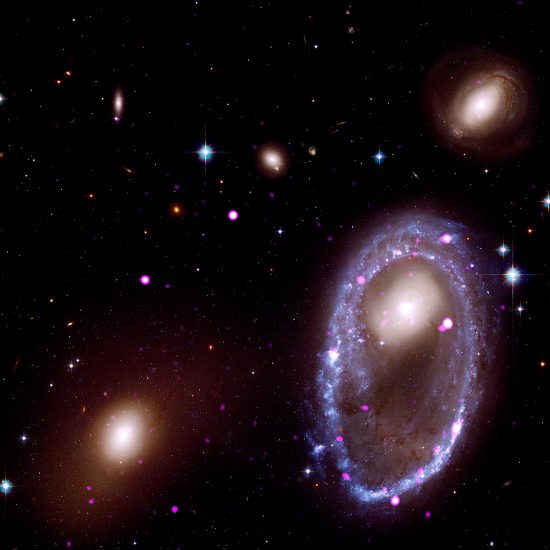
Sep 10, 2018
Black holes do not power this ring of stars.
Astronomers recently discovered what they believe to be a “ring of black holes or neutron stars” in galaxy AM 0644-741, located 300 million light years away. Observations from the Chandra X-ray Observatory are said to reveal stellar-mass black holes or neutron stars, encircling the galaxy.
They think the ring formed when gravity pulled one galaxy into another, causing ripples in the gas that created an expanding ring, triggering new star birth.
Rings are everywhere in astronomy. Rings around planets, rings around stars, and rings around galactic nuclei, such as AM 0644-741. The conventional explanation, as mentioned above, is that they are formed when one or more collisions between galaxies take place.
On the other hand, from an Electric Universe perspective, stellar haloes like AM 0644-741 could be examples of a dense plasma focus penumbra. Images taken of plasma gun experiments provide a direct analogue to its galaxy-scale discharge.
A dense plasma focus is built from two electrodes made of copper or beryllium cylinders, one inside the other. They are confined within a vacuum chamber, with low pressure gas between the cylinders. An electric pulse is sent across the electrodes, causing electric charge to flow from the outer electrode to the inner electrode for a few milliseconds. The electric arc heats the gas between the cylinders, creating a plasma and an intense magnetic field. The magnetic field “pinches” the plasma into tiny filaments called a charge sheath.
The filament sheath flashes to the end of the inner electrode, where the plasma compresses into a magnetically confined “plasmoid.” The magnetic field decays, inducing an electric field that accelerates an electron beam in one direction and a beam of positive ions in the other. The electron beam heats the plasmoid to energies of 100,000 electron volts, the equivalent to billions of Kelvin in temperature.
AM 0644-741 is most likely equivalent to the rings that surround SN1987a, except on a galactic scale. As the electric current pinches down, variations in plasma density cause individual filaments in the gun’s current sheath to glow. Double layers accelerate the charge carriers that then emit extreme ultraviolet light and X-rays.
Just as the helical strands from the core of galaxy NGC 3079 are an indication that electricity is discharging from its nucleus, the swirling toroids that constrain the hot stars in the halo of AM 0644-741 conform to the Electric Universe theory.
A signature phenomenon in a dense plasma focus is helical strands of energy surrounding a powerful arc-mode discharge and a dark-current torus. The strands are plasma confined by magnetic fields into something like “power lines” in space, otherwise known as Birkeland currents. That phenomenon is present in the plasma gun discharge that makes up AM 0644-741.
Stephen Smith
Apologies to Alfred Lord Tennyson.
The Thunderbolts Picture of the Day is generously supported by the Mainwaring Archive Foundation.












